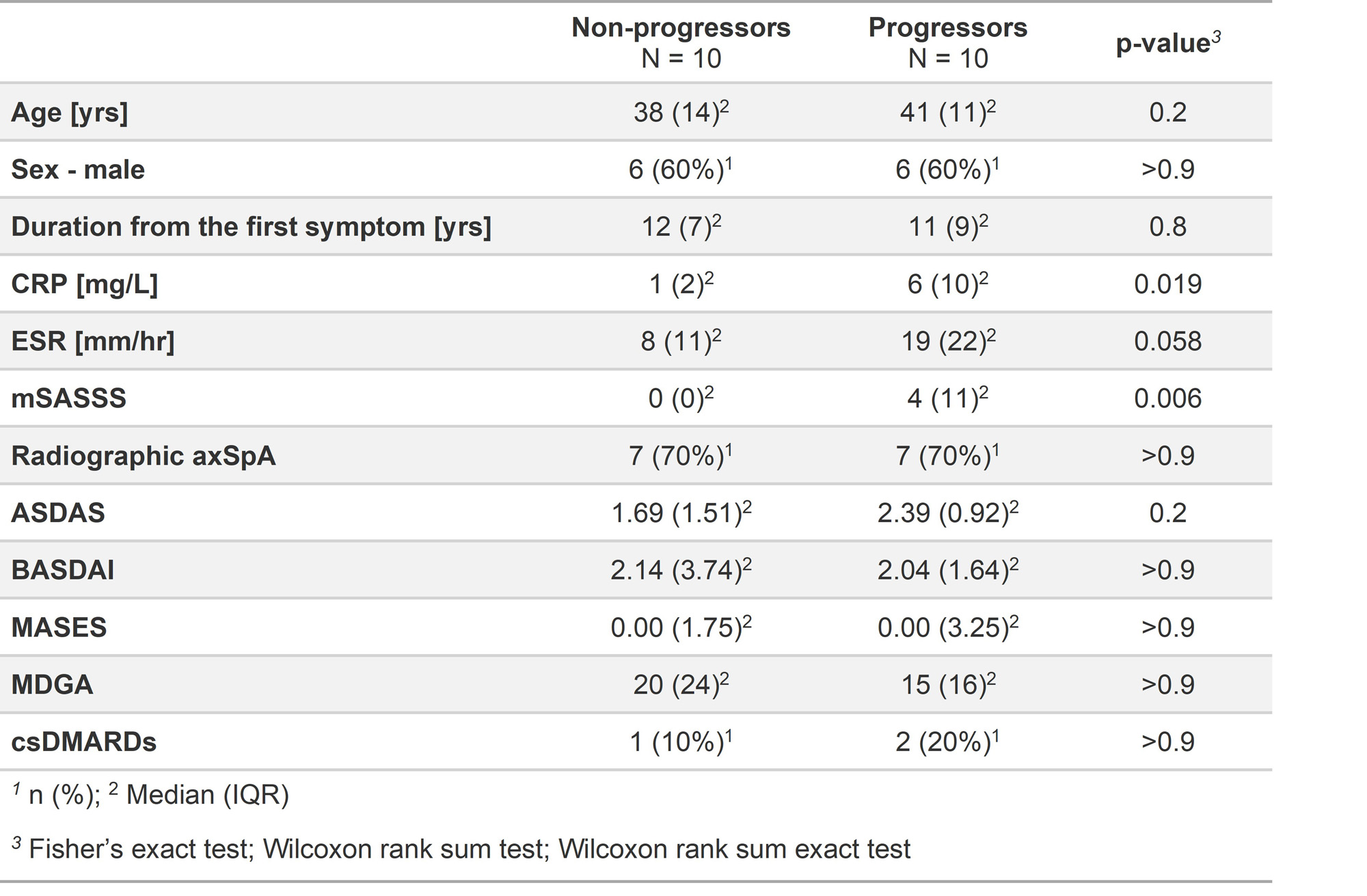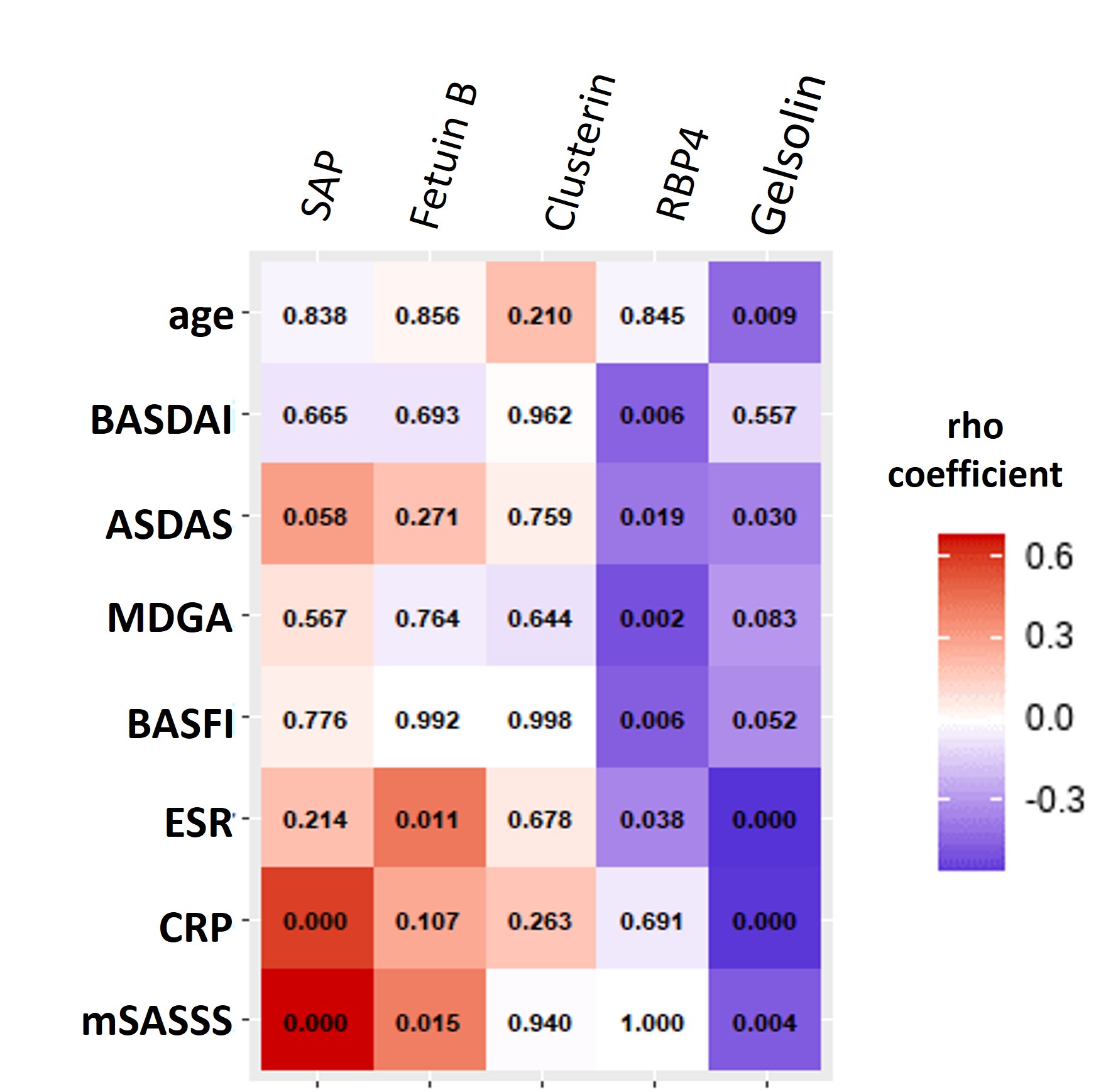Session Information
Date: Tuesday, November 14, 2023
Title: (1776–1795) Spondyloarthritis Including Psoriatic Arthritis – Basic Science Poster
Session Type: Poster Session C
Session Time: 9:00AM-11:00AM
Background/Purpose: Axial spondyloarthritis (AxSpA) is a frequent inflammatory disease with a significant impact on a patient’s quality of life. Therefore, early diagnosis and recognition of patients with rapid structural progression are of great importance. This pilot study aimed to profile the plasma proteome and disclose candidate biomarkers differentiating patients with structural radiographic progression after two years.
Methods: Twenty patients with ax-SpA fulfilling the ASAS classification criteria were selected according to an increase in the modified Stoke Ankylosing Spondylitis Spinal Score (mSASSS) after a 2-year follow-up into radiographic progressors (ΔmSASSS ≥2) and non-progressors (ΔmSASSS = 0). Patients’ disease activity was determined using C-reactive protein (CRP), Erythrocyte Sedimentation Rate (ESR), Ankylosing Spondylitis Disease Activity Score (ASDAS), Bath Ankylosing Spondylitis Functional Index (BASFI), Bath Ankylosing Spondylitis Activity Disease Activity Index (BASDAI) and physician global assessment (MDGA). The plasma proteome was profiled using the mass spectrometry method and statistical analysis was adjusted for CRP. All patients were naïve to b/ts DMARDs during the 2-year follow-up.
Results: Our cohort included ten patients without radiographic spinal progression (non-progressors) and ten patients who developed significant progression after two years (progressors) (mean±SD ΔmSASSS 9.88±5.1). All demographic and clinical characteristics are provided in Table 1. The profiling of plasma proteome revealed 489 quantifiable proteins, out of which 21 proteins were different between patient groups (ANOVA-computed p< 0.05 for all). The follow-up pairwise comparison revealed five promising biomarkers, out of which clusterin (1.20-fold, p=0.011), serum amyloid P-component (SAP) (1.43-fold, p< 0.004), retinol-binding protein 4 (RPB4) (1.28-fold, p=0.027), and fetuin-B (1.52-fold, p=0.051) were upregulated, while gelsolin (1.16-fold, p = 0.015) was downregulated in patients with mSASSS progression compared to those without progression (Fig. 1). Out of these proteins, gelsolin, RBP4, fetuin-B, and SAP significantly correlated with mSASSS, CRP or ASDAS (Fig. 2). All candidate proteins have previously been associated with rheumatic diseases.
Conclusion: This pilot study revealed five plasma proteins, which are likely to predict the structural progression of axSpA after two years. These data will be validated in an extended larger cohort.
Acknowledgements: Supported by SVV 260 523, BBMRI-CZ LM2018125, and MHCR No. 023728.
To cite this abstract in AMA style:
Baloun J, Bubova K, Pekacova A, Ondrejcakova L, Cervenak V, Gregova M, Forejtova S, Horinkova J, Gatterova J, Tomcik M, Vencovsky J, Pavelka K, Senolt L. Biomarkers Predicting Structural Progression of Axial Spondyloarthritis: A Pilot Study [abstract]. Arthritis Rheumatol. 2023; 75 (suppl 9). https://acrabstracts.org/abstract/biomarkers-predicting-structural-progression-of-axial-spondyloarthritis-a-pilot-study/. Accessed .« Back to ACR Convergence 2023
ACR Meeting Abstracts - https://acrabstracts.org/abstract/biomarkers-predicting-structural-progression-of-axial-spondyloarthritis-a-pilot-study/



